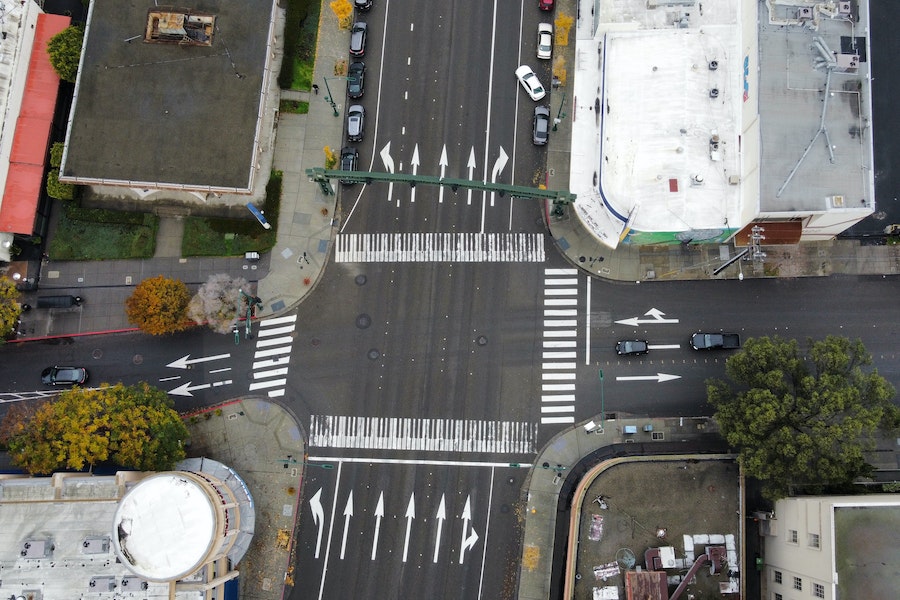
They are in almost every city and some neighborhoods—you know, that intersection where it seems an accident occurs every day. Whether it’s a minor fender bender or a serious vehicle collision, some intersections are simply more dangerous than others.
While closing your eyes and crossing your fingers for luck isn’t an option, navigating the risks at dangerous intersections is possible. Let’s review a few helpful tips to help you make it safely through a risky intersection.
What Makes An Intersection Dangerous
You simply cannot avoid driving through an intersection since cross streets are literally everywhere. Whether it’s two, four, or more streets intersecting, you’ll cross through an intersection at some point in your life.
Adding to your worry about intersections are the national averages. According to the Federal Highway Administration, accidents in intersections are second in frequency to rear-end collisions. About 50% of vehicle accidents occur in intersections. So, what makes intersections so dangerous for drivers?
Driver inattention is one of the primary causes of car accidents in intersections, where maybe the driver is temporarily distracted by their phone or lost in thought. In other cases, drivers may be in a hurry and rush through the intersection. Regardless of why a driver isn’t paying attention, this lack of noticing their surroundings is a leading cause of vehicle accidents.
Sometimes, drivers become overly familiar with an intersection, or maybe they’re used to being the only vehicle on the road at that time. Instead of coming to a full stop, they barrel through accidentally, hitting a car with the right-of-way. While this type of car accident is more common at intersections with stop signs, it can also occur at traffic lights.
How To Safely Navigate Risky Intersections
The lessons you learned during driver’s training will help you safely navigate intersections. If you have forgotten some of the tips, here’s a quick refresher.
Always Pay Attention
Do you remember being told to look both ways before crossing a street? This is great advice to follow when you’re crossing an intersection. Staying alert and paying constant attention to your surroundings can help prevent most types of vehicle accidents.
Before going through an intersection, always look in every direction—this advice even applies when the intersection has a traffic light. Remember, not all drivers stop the second the light turns red, which means you can still get into an accident when you have a green light.
Sometimes, visibility at intersections is blocked by trees, buildings, or signs, so always opt to go slow at these intersections. You never know when a pedestrian or cyclist may be in the crosswalk.
Keep Your Speed Slow
Everyone’s always in a hurry, which often results in a traffic accident. In fact, the NHTSA (National Highway Traffic Safety Administration) estimates that 8.4% of car accidents in intersections result from drivers making assumptions about other vehicles.
Maybe you think a vehicle is going to continue straight through the intersection, but it suddenly makes a turn. All of a sudden, your vehicle is involved in a side-impact collision. Instead of speeding through an intersection when it’s finally your turn, take it slow—especially when oncoming traffic is involved. Getting into a vehicle accident isn’t going to get you to your destination any faster.
Don’t Crowd the Vehicle in Front of You
You already know the dangers of tailgating, and no, not the type of tailgating you do at sporting events. This type of tailgating refers to keeping a distance between your vehicle and the one in front of you.
If you haven’t heard of the three-second rule, it’s one you want to become familiar with. The three-second rule in driving refers to how long you wait before following another vehicle.
Waiting just a few seconds to cross an intersection after another driver can make all of the difference in preventing a rear-end collision. The lead driver may suddenly stop to avoid hitting an obstacle, like an unseen pedestrian. If you follow this rule, you can minimize your chances of being involved in a traffic accident.
Always Use Your Turn Signal
Vehicles have turn signals for a valid reason— when you activate the turn signal, it alerts other drivers to your intentions. Chances are you’ve complained about other drivers changing lanes without signaling or turning without warning, so don’t become one of those drivers.
Even if you’re in a dedicated turn-only lane, still use your turn signal. Oncoming drivers may not be aware of the lane’s purpose. Also, in most states, it’s the law to always use your turn signal. If you’re involved in a vehicle collision, you may be the at-fault driver for failing to use your turn signal—this ticket is easy to avoid, along with the accident itself.
Use Caution When Entering an Intersection
What you may think is the safest time to enter an intersection can actually often be the most dangerous. When the light first changes to green, drivers often presume it’s safe to proceed, but unfortunately, this is often when accidents happen.
Drivers often see a yellow light and speed up to get through an intersection before it turns red, and often, the light is red as the vehicle is crossing. Now you have a green light, but there’s still a car in the middle of the crossing—suddenly, you’re involved in a vehicle accident.
This type of accident can also happen in intersections with stop signs, especially when no one’s sure who has the right-of-way. Always look in every direction before pulling out into an intersection, and proceed cautiously. Following these simple driving tips can help make even a risky intersection safe to drive through.
Involved In An Accident In An Intersection? Contact An Attorney
Whether the car accident is your fault or due to the other driver’s negligence, it’s always good advice to consult with an attorney. Navigating who is at fault in any type of accident can be complicated, especially when it occurs at an intersection.
In these instances, talking to an experienced accident attorney will help protect the legal rights of everyone involved in a vehicle collision.








